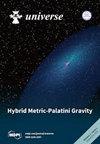利用潘神数据集对最小扩展光速变化模型的约束+
IF 2.6
4区 物理与天体物理
Q2 ASTRONOMY & ASTROPHYSICS
引用次数: 0
摘要
在最小扩展光速变化(meVSL)模型的背景下,Ia 型超新星(SNe Ia)的绝对大小和光度距离都偏离了广义相对论(GR)的预测。利用 Pantheon+ 勘测的数据,我们评估了 meVSL 框架内各种暗能量模型的合理性。暗能量模型的恒定状态方程(EoS)(ωCDM)和切瓦利埃-波拉斯基-林德参数化模型(CPL)(ω=ω0+ωa(1-a))都表明宇宙光速在 1-σ 置信度水平上存在潜在变化。当ωm0=0.30、0.31和0.32,(ω0,ωa)=(-1,0)时,c˙0/c0(10-13yr-1)的1-σ范围分别为(-8.76, -0.89)、(-11.8, 3.93)和(-14.8, -6.98)。同时,对于-1.05≤ω0≤-0.95和0.28≤ωm0≤0.32的CPL暗能量模型,c˙0/c0(10-12yr-1)的1-σ范围为(-6.31,-2.98)。ωCDM模型在z=3时的c值可能比现在的c值超出0.2∼3%,CPL模型超出5∼13%。此外,除了ωm0=0.28的CPL模型之外,其他可行模型的-25.6≤G˙0/G0(10-12yr-1)≤-0.36。对于这个特殊模型,我们得到引力常数的增加率在 1.65≤G ˙0/G0(10-12yr-1)≤3.79 的范围内。通过统计解释,我们得到了一些不需要暗物质能量密度的模型。然而,这只是模型参数与能量密度之间的退化效应,并不意味着暗物质是不必要的。本文章由计算机程序翻译,如有差异,请以英文原文为准。
Constraints on the Minimally Extended Varying Speed of Light Model Using Pantheon Dataset+
In the context of the minimally extended varying speed of light (meVSL) model, both the absolute magnitude and the luminosity distance of type Ia supernovae (SNe Ia) deviate from those predicted by general relativity (GR). Using data from the Pantheon+ survey, we assess the plausibility of various dark energy models within the framework of meVSL. Both the constant equation of state (EoS) of the dark energy model (ωCDM) and the Chevallier–Polarski–Linder (CPL) parameterization model (ω=ω0+ωa(1−a)) indicate potential variations in the cosmic speed of light at the 1−σ confidence level. For Ωm0=0.30,0.31, and 0.32 with (ω0,ωa)=(−1,0), the 1−σ range of c˙0/c0(10−13yr−1) is (−8.76, −0.89), (−11.8, 3.93), and (−14.8, −6.98), respectively. Meanwhile, the 1−σ range of c˙0/c0(10−12yr−1) for CPL dark energy models with −1.05≤ω0≤−0.95 and 0.28≤Ωm0≤0.32 is (−6.31, −2.98). The value of c at z=3 can exceed that of the present by 0.2∼3% for ωCDM models and 5∼13% for CPL models. Additionally, for viable models except for the CPL model with Ωm0=0.28, we find −25.6≤G˙0/G0(10−12yr−1)≤−0.36. For this particular model, we obtain an increasing rate of the gravitational constant within the range 1.65≤G˙0/G0(10−12yr−1)≤3.79. We obtain some models that do not require dark matter energy density through statistical interpretation. However, this is merely an effect of the degeneracy between model parameters and energy density and does not imply that dark matter is unnecessary.
求助全文
通过发布文献求助,成功后即可免费获取论文全文。
去求助
来源期刊

Universe
Physics and Astronomy-General Physics and Astronomy
CiteScore
4.30
自引率
17.20%
发文量
562
审稿时长
24.38 days
期刊介绍:
Universe (ISSN 2218-1997) is an international peer-reviewed open access journal focused on fundamental principles in physics. It publishes reviews, research papers, communications, conference reports and short notes. Our aim is to encourage scientists to publish their research results in as much detail as possible. There is no restriction on the length of the papers.
 求助内容:
求助内容: 应助结果提醒方式:
应助结果提醒方式:


